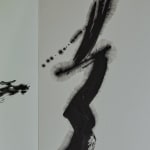Morita Shiryū (1912–1998)
Kumo mushin
Ink on paper, four-panel folding screen
c. 1967
With a label signed by Inada Sousai
141 x 280 cm (overall)
c. 1967
With a label signed by Inada Sousai
141 x 280 cm (overall)
Literature
Morita Shiryu Catalogue Raisonné: 1952–1998. Uji: Soryusha, 2019.
Kumo mushin was shown at the Montreal Expo 67 (1967), together with another of Morita’s works of the same subject matter. Morita recounted the following about the origin of the characters:
It is a quote from a Zen text, I believe. ‘The clouds aimlessly rose from the peaks.
The birds, weary of flying, know it is time to come home.’ Free from obstructive thought,
the mind is floating like a cloud. Knowing that the bird will invariably return home
when it’s tired is not intellectual knowledge, but intuitive: When the evening approaches
it will return to the mountains, as if directed by some invisible force.
Abandoning itself to this force, it will naturally find its way home. I think we need to reflect on
the importance of such teaching and what it could mean for us as human beings,
so I used this term for subject matter. I would like to find this state of self
of being unaffected by obstructions. (Bokujin 145, 1967)
Mu, the concept of a natural state where one discards any ostentation, was a concept of particular importance to Morita. Kumo mushin is one of the variations on mu that allowed the artist to give external shape to its meaning. Morita began writing the character kumo 雲, abbreviated here to its radical 云, in the upper center, then swiftly connects to mu, which lingers as if suspended in mid-air on the right of the composition, only to descend rapidly, almost like a lightning bolt. The final character shin takes up the narrow space near the central lower part of the work. Morita writes the three characters in a continuous brush movement as if they were just one, suggesting the inner state of the unobstructed mind.
Morita Shiryu (avant-garde calligrapher; 1912–1998)
Avant-garde calligrapher from Hyogo Prefecture. Like fellow artist Inoue Yuichi, Morita studied under the calligraphy master Ueda Sokyu. He co-founded the avant-garde group Bokujinkai together with Inoue and was the founder and editor of the journal Bokubi (Beauty of Ink), both of which revolutionized traditional Japanese calligraphy and spread knowledge of Japanese avant-garde calligraphy to an international audience. He was posthumously awarded the Medal of Honor with Dark Blue Ribbon.
It is a quote from a Zen text, I believe. ‘The clouds aimlessly rose from the peaks.
The birds, weary of flying, know it is time to come home.’ Free from obstructive thought,
the mind is floating like a cloud. Knowing that the bird will invariably return home
when it’s tired is not intellectual knowledge, but intuitive: When the evening approaches
it will return to the mountains, as if directed by some invisible force.
Abandoning itself to this force, it will naturally find its way home. I think we need to reflect on
the importance of such teaching and what it could mean for us as human beings,
so I used this term for subject matter. I would like to find this state of self
of being unaffected by obstructions. (Bokujin 145, 1967)
Mu, the concept of a natural state where one discards any ostentation, was a concept of particular importance to Morita. Kumo mushin is one of the variations on mu that allowed the artist to give external shape to its meaning. Morita began writing the character kumo 雲, abbreviated here to its radical 云, in the upper center, then swiftly connects to mu, which lingers as if suspended in mid-air on the right of the composition, only to descend rapidly, almost like a lightning bolt. The final character shin takes up the narrow space near the central lower part of the work. Morita writes the three characters in a continuous brush movement as if they were just one, suggesting the inner state of the unobstructed mind.
Morita Shiryu (avant-garde calligrapher; 1912–1998)
Avant-garde calligrapher from Hyogo Prefecture. Like fellow artist Inoue Yuichi, Morita studied under the calligraphy master Ueda Sokyu. He co-founded the avant-garde group Bokujinkai together with Inoue and was the founder and editor of the journal Bokubi (Beauty of Ink), both of which revolutionized traditional Japanese calligraphy and spread knowledge of Japanese avant-garde calligraphy to an international audience. He was posthumously awarded the Medal of Honor with Dark Blue Ribbon.



